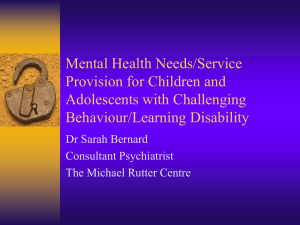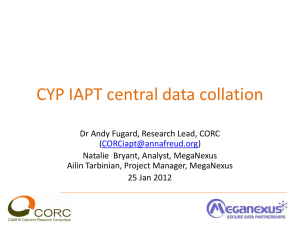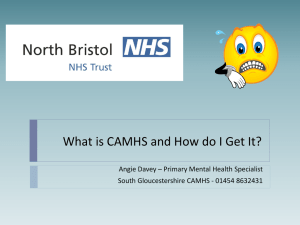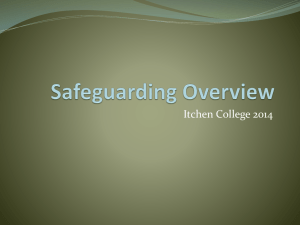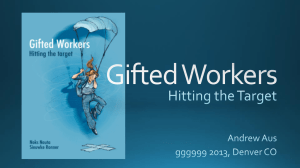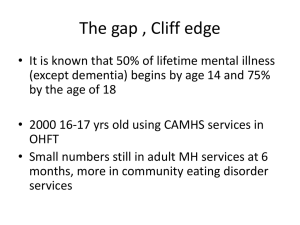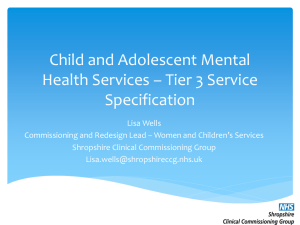Mary John
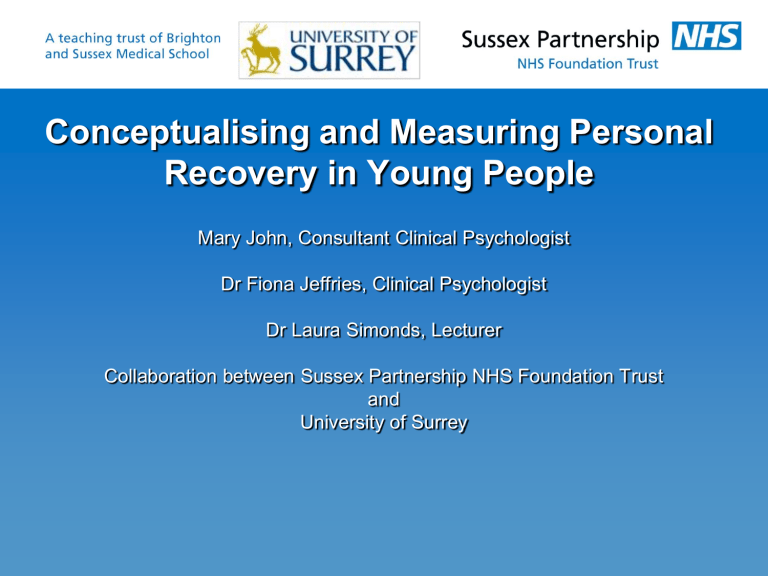
Conceptualising and Measuring Personal
Recovery in Young People
Mary John, Consultant Clinical Psychologist
Dr Fiona Jeffries, Clinical Psychologist
Dr Laura Simonds, Lecturer
Collaboration between Sussex Partnership NHS Foundation Trust and
University of Surrey
Other members of the research group
Dr Fiona Warren - Lecturer
Dr Nikki Stone – Clinical Psychologist
Dr Rebecca Pons – Clinical Psychologist
Dr Claire Arthern - Clinical Psychologist
Dr Marcela Acuna-Rivera – Research Officer
Laura Cotton – Graduate Psychology Student
What is Personal Recovery?
• Emphasis on developing meaning and fulfilment in the continued presence of symptoms
• Unique to the individual; but recovery models suggest common aspects:
• hope
• social connectedness
• meaning
• empowerment
• valued activities
• The current recovery literature is narrow (adult-centric, psychosisfocused, few empirical studies)
• Politically-driven (‘survivors’ and ‘activists’)
• ‘Recovery’ is associated with cure in common parlance
This raises a number of questions and challenges:
• How do we understand whether personal recovery has relevance and resonance in other groups of people (e.g. young people and their families)?
• How do we understand what it means in people with conditions other than psychosis?
• How do we understand what it means without using the term ‘recovery’ or organising data collection around pre-existing frameworks?
Aims & Methodology – Part 1
Using an inductive approach, to develop a conceptual framework of recovery in young people and mothers
• Interviews with 10 young people, 16 mothers [11 CAMHS professionals]
• Tell us about the time before, during and after being in CAMHS
• Thematic Analysis
• Comparison with adults frameworks:
‘Loss of self’ (similar to Andresen et al.’s ‘moratorium’ and Spaniol et al.’s
‘overwhelmed by the disability’)
‘Renegotiating the self’ (similar to Andresen et al’s ‘awareness’ and Spaniol et al’s ‘struggling with the disability’)
Little conceptual similarity with later stages of adult models regarding future thinking and responsibility
Aims & Methodology – Part 2
To develop an initial instrument based on this conceptual framework; to establish if scores on this instrument relate to symptoms in a predictable way
• Content analysis of items (c200) from interviews
• Development of Request-YP (30 items), Request-P (28 items), Request-PYP (35 items)
• Administered with measures of emotional problems
(SDQ) and self-esteem (Rosenberg)
Sample:
• 47 young people aged 10-18 (M 14.7, SD 2.37), 37 girls and 10 boys, in CAMHS for an average of 2.5 years
• 55 parents aged 31-59 (M 44.1, SD 5.16), 52 mothers and 3 fathers
• N=40 child-parent pairs
Structure & Content of Measures
Single score to reflect degree of ‘recovery’ (not stage-based)
Factor analysis not viable in small sample
0 (not at all) to 3 (completely) scaling; thinking of the past week
Request-YP
(young person on self)
Request-PYP
(parent on young person)
Request-P
(parent on self)
I do not see my friends because of how I feel
My child seems to be isolated
I cope with my problems much better than before
I do not understand my problems at all
My child can deal with a lot of stressful situations
My child understands why they feel the way they do
I realise that my child is not the only one with these difficulties
I have become stronger and can cope with more
I understand my child’s difficulties more
Results
Good internal reliability for all 3 measures
(Cronbachs alpha .89 - .95)
Young people scoring in the ‘normal’ range of SDQ had significantly higher ‘recovery’ scores
• Normal vs abnormal r = -.72
• Normal vs borderline r= -.57
Request-YP scores were highly positively correlated with self-esteem (.8)
Results
Positive correlation between child self-report and parent report on the child (using parent-child pairs only): r=.61
And between parent report on self and report on their child: r=.78
There were no significant correlations between Request measures and duration in CAMHS or child age.
Critical Discussion
Novel work – almost no other CAMHS recovery studies
• Therefore, very limited data so far
Offers more questions than conclusions?
• Is this recovery?
• Is it different to adolescent maturation? Or self esteem?
• What comprises the Request measures and might different aspects correlate with symptoms in different ways?
The Request measures do not tap specific anxiety/depression symptoms but are correlated in a predictable way with the
SDQ: potential to be used in clinical evaluation and outcome measurement alongside symptom-based measures?
Questions?
Mary John: mary.john@sussexpartnerhip.nhs.uk; m.john@surrey.ac.uk
Fiona Jeffries: fiona.jeffries@gosh.nhs.uk
Laura Simonds: l.simonds@surrey.ac.uk
